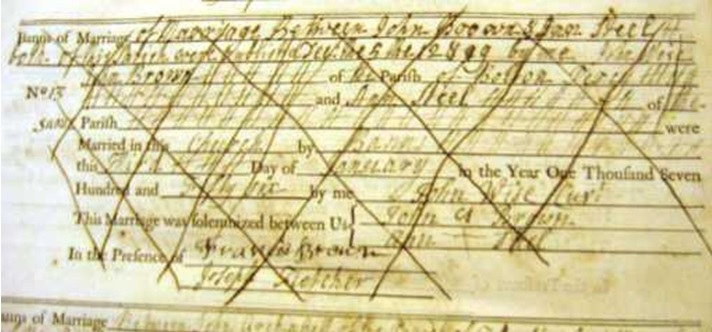In January 1756 (1757 in modern dating) the parish register of the small parish of Bolton Percy, about 8 miles from York, recorded the marriage of Ann Steel, daughter of a large family who had lived in the parish for several generations, and John Brown, a labourer. The couple married by banns. That is, they did not purchase a special licence but had their intended marriage announced in the parish church on three successive weeks before the ceremony, when those present had the chance to object. At Easter 1757, the marriage was unproblematic – it was included in the annual return made to the archbishop of ceremonies that had taken place in the church in the last year (known as the Parish Register Transcripts or Bishop’s Transcripts). However, a later hand crossed through the marriage entry in the register. Why did this happen?

The answer appears in a parallel register, of marriages, baptisms and burials, kept by the curate of the parish. This may have been copied up in arrears several years at a time. This register also gives John and Ann’s marriage entry, but underneath is a note that John Brown was “afterwards discovered to be a woman dressed in man’s apparel and of course separated from the said Ann Steel”.

The circumstances of the discovery are not given but we do know that a “John Brown” was recognised as a woman in York in 1760, when trying to enlist as a soldier with the infantry. The York Courant recorded the discovery in a short piece repeated in a slightly abbreviated version in the London Gazette. John Brown was in fact Barbara Hill, who had been born in York. Whilst enlisting she was recognised by someone who had known her as a child and at once discharged. The papers also reported the arrival in York of her “supposed wife”, who came begging that they should not be separated. Barbara gave an account of her life since leaving York fifteen years earlier. She had run away from the city as a young servant, leaving her female clothes behind her. She claimed to have travelled south and been apprenticed to a stonecutter for five years, then to have worked as a farmer and then in London as a coach-driver before returning to Yorkshire, first to Pontefract and then to Bolton Percy. Checking this part of Barbara’s story in the sources is difficult – but a case involving a disappeared or run away servant may have appeared in local papers or even in the records of the local secular courts at York: these records are held at the York City Archive.
Probably her father was the Leonard Hill who had become a freeman of the city of York in 1729/30. He had been the apprentice of Thomas Thackray, linen draper. She claimed to have been born in York and a Barbara Hill, daughter of Leonard Hill, was baptised at St Helen’s Church, York on 8 March 1731/2.

There are no other references to the family in the St Helen’s registers but two other children of a Leonard Hill were baptised in the church of St Michael le Belfrey (the neighbouring parish): Theodora, baptised 3 November 1734 who died in 1738 and Sarah christened 8 August 1736. It is likely all these were the same family – Leonard was an unusual Christian name and it is unlikely there were two Leonard Hills in such a small area. Unfortunately, Leonard Hill died in March 1741/2: his burial appears in the register of St Michael le Belfrey. He left no will that we know of. This probably left his family without means of support when Barbara was about 10. If she had left York in 1745 (as she claimed) soon after becoming a servant then she would have entered service at 13 or 14 years of age.
Ann Steele appears to have married again in Bolton Percy in 1765, to a William Browne, but after 1760, there are no further records of Barbara Hill. As an irregular marriage, the case could have led to a prosecution in the church courts but there seem to be no entries in the court books of the archbishop or of the Dean and Chapter. The case may also have appeared in local secular courts, like some other cases of the eighteenth century where women attempted to enlist, and a search of the records of these courts, held at the York City Archive, may be fruitful. The case could also be compared to those in some well-known pamphlets of the mid-eighteenth century, recording cross-dressing women, Henry Fielding’s The Female husband, published in 1746, and The Female Soldier, printed in 1750. There are microfilm copies of both in the University of York’s Library.